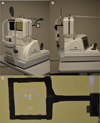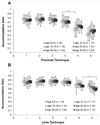Accommodative Gain in Relation to Perceived Target Clarity
- PMID: 26421684
- PMCID: PMC4812439
- DOI: 10.1097/OPX.0000000000000711
Accommodative Gain in Relation to Perceived Target Clarity
Abstract
Purpose: The purpose of this study is to determine the relationship between target clarity and the magnitude of accommodative lag using the metric accommodative gain (AG).
Methods: Monocular accommodative responses were measured with Grand Seiko autorefraction using both proximal and minus lens techniques in 139 subjects aged 5 to 35 years. Subjects viewed a 1.5-mm letter at 13 discrete distances (range, 40 to 3.33 cm) for the proximal technique and fixed at 33 cm through minus lenses of increasing power for the lens technique. Subjects were instructed to keep the target clear and report when it blurred. The AG was calculated (accommodative response/accommodative demand) for the four greatest consecutive demands perceived clear (termed conditions 1 to 4) and the first demand perceived blurry (termed condition 5).
Results: Multivariate planned contrast, including age as a predictor, revealed that mean AG was significantly larger when the target was clear (range, 0.71 to 0.77 for conditions 1 to 4 across techniques) versus blurry (0.59 and 0.68 for condition 5 across techniques) (p < 0.001 for proximal and p < 0.036 for lens). Age was only a contributing factor for the proximal technique, with the youngest subjects having the largest decrease in AG when the target changed from clear to blurry (p = 0.017).
Conclusions: These data suggest that across age and technique, the AG is relatively constant when the target is perceived clear but drops below approximately 70%, on average, once the target is perceived as blurry for subjects aged 5 to 35 years. The AG may be a useful metric to compare accommodative responses across a range of demands and to identify accommodative responses that may not be sufficient to perceive a clear target.
Figures






Similar articles
-
Minus lens stimulated accommodative lag as a function of age.Optom Vis Sci. 2009 Jun;86(6):685-94. doi: 10.1097/OPX.0b013e3181a7294f. Optom Vis Sci. 2009. PMID: 19417707 Free PMC article.
-
Subjective versus objective accommodative amplitude: preschool to presbyopia.Optom Vis Sci. 2014 Nov;91(11):1290-301. doi: 10.1097/OPX.0000000000000402. Optom Vis Sci. 2014. PMID: 25602235 Free PMC article.
-
Changes in accommodative and vergence responses when viewing through near addition lenses.Optometry. 2007 Mar;78(3):129-34. doi: 10.1016/j.optm.2006.08.017. Optometry. 2007. PMID: 17321462
-
The effect of target proximity on the aniso-accommodative response.Ophthalmic Physiol Opt. 1999 Sep;19(5):376-92. doi: 10.1046/j.1475-1313.1999.00452.x. Ophthalmic Physiol Opt. 1999. PMID: 10768019
-
Accommodative response under monocular and binocular conditions as a function of phoria in symptomatic and asymptomatic subjects.Clin Exp Optom. 2014 Jan;97(1):36-42. doi: 10.1111/cxo.12074. Epub 2013 Jun 27. Clin Exp Optom. 2014. PMID: 23808381
Cited by
-
Blur Detection, Depth of Field, and Accommodation in Emmetropic and Hyperopic Children.Optom Vis Sci. 2018 Mar;95(3):212-222. doi: 10.1097/OPX.0000000000001177. Optom Vis Sci. 2018. PMID: 29401180 Free PMC article.
-
Impact of Visual Cues on the Magnitude and Variability of the Accommodative Response in Children With Emmetropia and Uncorrected Hyperopia and Adults.Invest Ophthalmol Vis Sci. 2019 Apr 1;60(5):1527-1537. doi: 10.1167/iovs.18-25256. Invest Ophthalmol Vis Sci. 2019. PMID: 30994863 Free PMC article.
-
Vergence, accommodation, and visual tracking in children and adolescents evaluated in a multidisciplinary concussion clinic.Vision Res. 2021 Jul;184:30-36. doi: 10.1016/j.visres.2021.03.002. Epub 2021 Apr 7. Vision Res. 2021. PMID: 33838503 Free PMC article.
References
-
- McClelland JF, Saunders KJ. Accommodative lag using dynamic retinoscopy: age norms for school-age children. Optom Vis Sci. 2004;81:929–933. - PubMed
-
- Abbott ML, Schmid KL, Strang NC. Differences in the accommodation stimulus response curves of adult myopes and emmetropes. Ophthalmic Physiol Opt. 1998;18:13–20. - PubMed
-
- Gwiazda J, Thorn F, Bauer J, Held R. Myopic children show insufficient accommodative response to blur. Invest Ophthalmol Vis Sci. 1993;34:690–694. - PubMed
Publication types
MeSH terms
Grants and funding
LinkOut - more resources
Full Text Sources
Medical

